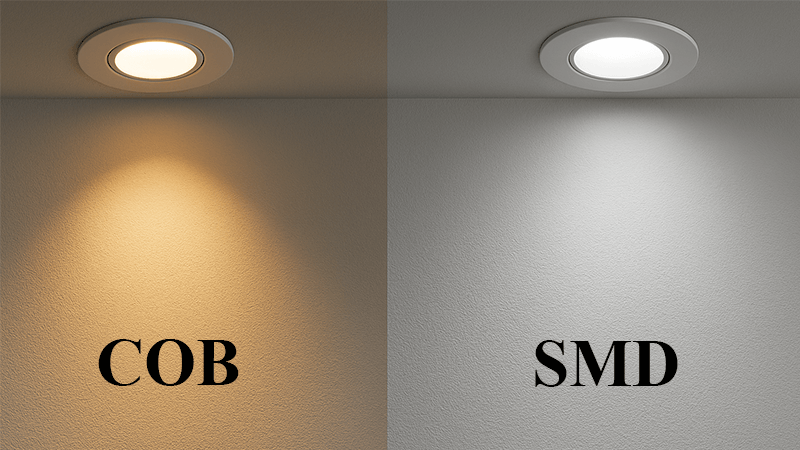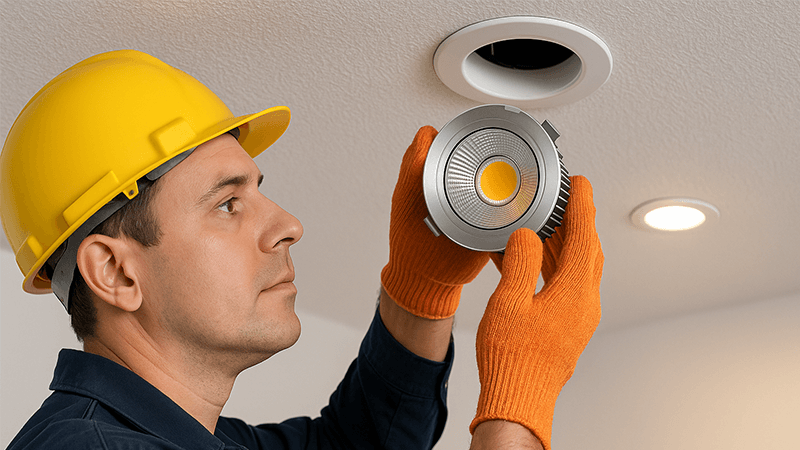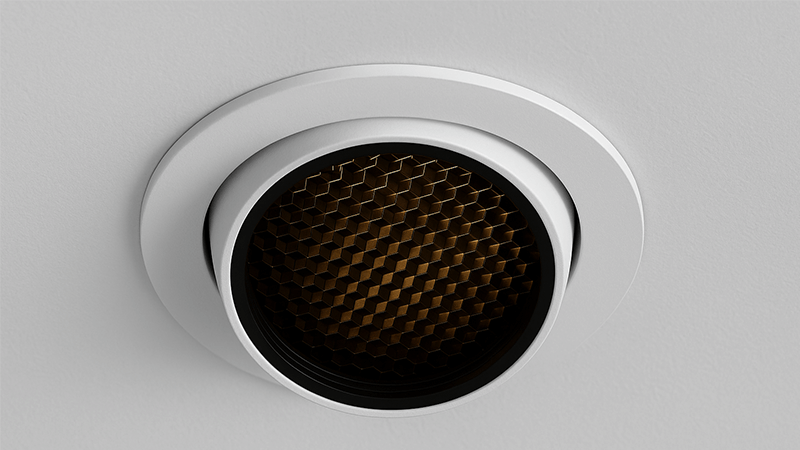Struggling to choose the right downlight for your project? The wrong choice can lead to poor lighting and unhappy clients. Understanding COB technology is the key to a brilliant solution.
A COB (Chip on Board) downlight is a fixture that uses a specific type of LED technology. Multiple LED chips are bonded directly onto a substrate to form a single, powerful module. This creates a dense, uniform light source from a very small area, unlike traditional multi-chip solutions.

Now that you know the basic definition, you probably have more questions. As a purchasing manager, you need to know more than just what it is. You need to understand how it compares to other options, its best uses, and its potential drawbacks. Let’s dig deeper into the details that matter for your projects, so you can source with confidence.
Is COB LED better than LED?
The debate between "COB LED" and "LED" can be confusing. Making the wrong assumption can lead to sourcing a product that doesn’t fit your project’s needs. Let’s clarify the difference.
COB isn’t inherently "better" than all LEDs; it’s a specific type of LED packaging. It excels at delivering a high-intensity, uniform beam from a compact source. This is different from SMD (Surface Mounted Device) LEDs, which consist of multiple individual light points spread over a larger area.

When people ask if COB is "better," they are usually comparing it to the most common alternative, SMD LEDs. The truth is, one is not superior to the other; they are simply different tools for different jobs. For someone like you, Shaz, understanding when to use each one is crucial for success. I’ve worked on many projects where choosing between COB and SMD was the deciding factor in the final lighting effect. The choice depends entirely on the desired outcome. For example, if you need a powerful, focused beam for a high-ceiling lobby, a COB downlight is the perfect choice. If you need diffuse, even light for general office illumination, an SMD panel might be better.
COB vs. SMD: What’s the Real Difference?
To make the best purchasing decision, you need a clear breakdown of their characteristics. Each technology has its strengths, and knowing them will help you match the product to the application perfectly.
| Feature |
COB (Chip on Board) |
SMD (Surface Mounted Device) |
| Light Appearance |
Single, uniform, intense beam |
Multiple, distinct points of light; can appear like stars |
| Light Quality |
Smooth light, no multi-shadow effect, excellent for focus |
Can create multiple shadows; good for diffuse, wide-area light |
| Heat Dissipation |
Centralized heat, efficient transfer to heatsink |
Heat is spread across multiple chips, multiple thermal paths |
| Best Application |
Spotlights, downlights, high-bay lights, accent lighting |
Panel lights, strip lights, bulbs, general area lighting |
| Design Flexibility |
Less flexible in creating shapes or color-changing |
Highly flexible for linear shapes and RGB/W color mixing |
Choosing the right one often comes down to the lighting effect you want to create. I remember a client for a luxury hotel who wanted dramatic lighting in the hallways. They needed to highlight artwork on the walls. We chose COB downlights with a narrow beam angle. The result was a series of beautiful, focused light pools that made each piece of art a focal point. Using SMDs would have scattered the light and washed out the dramatic effect they were after.
What is the purpose of a COB light?
You see COB technology used in many fixtures, but you might not be sure of its ideal use. Using it in the wrong application means wasted potential and poor lighting design.
The main purpose of a COB light is to produce a high-intensity and highly uniform beam of light from a very small area. This makes it perfect for applications requiring powerful, focused illumination, such as spotlights, track lights, and downlights for high ceilings.

Think of a COB light as a specialist. Its design purpose is very specific: to deliver a punch of light exactly where you need it. This ability to create high lumen density—a lot of light from a tiny source—is its greatest strength. This is why it has become the go-to technology for accent and task lighting in both commercial and residential spaces. For a purchasing manager, knowing this core purpose helps you quickly identify if a COB-based product is the right fit for a project’s requirements. When a designer specifies "dramatic," "focused," or "high-impact" lighting, COB should be the first technology that comes to your mind.
Key Applications Driven by COB’s Purpose
Understanding the purpose helps you see why COB is chosen for certain applications. Let’s look at where it shines and why.
-
Retail and Showroom Lighting: The goal here is to make products look irresistible. COB downlights and track lights are perfect for this. Their intense, focused beam can be directed to highlight merchandise, creating contrast and drawing the customer’s eye. High CRI (Color Rendering Index) COB chips ensure that the colors of clothing, jewelry, or cars look vibrant and true to life.
-
Hospitality (Hotels, Restaurants): In hospitality, lighting creates mood and atmosphere. COB downlights can create dramatic accent lighting on tables in a restaurant or highlight architectural features in a hotel lobby. Their ability to deliver a clean, single-shadow light adds a touch of sophistication that you can’t get with other light sources.
-
Galleries and Museums: This is where COB technology is mission-critical. Lighting artwork requires precision. You need to illuminate the piece without spilling light onto the wall around it. COB spotlights with adjustable beam angles and good optics allow for precise control, ensuring the art is the star of the show while protecting it from damaging UV or IR radiation.
-
High-Ceiling Applications: In spaces with high ceilings, like atriums, airports, or convention centers, you need light with enough power to reach the floor. A standard LED might disperse too much and lose its intensity. A COB downlight or high-bay light has the punch to deliver bright, usable light even from great heights.
What is the disadvantage of COB light?
While COB offers great benefits, it’s not perfect for every situation. Ignoring its disadvantages can lead to design compromises or maintenance issues down the road. Let’s look at the limitations.
A key disadvantage of COB technology is its lack of versatility. The chips are designed as a single, fixed module, making them unsuitable for creating colorful or linear lighting effects. Also, if one part of the chip fails, the entire module usually needs to be replaced.

From my experience in manufacturing, these are practical points that a buyer like you must consider. The "all-or-nothing" nature of the COB chip is its biggest drawback. Unlike an SMD fixture where one or two failed diodes might not be noticeable, a single point of failure on a COB chip can cause the entire light to go out. This has implications for maintenance and long-term cost. Furthermore, the single-color nature of most COB chips means they are not the right choice for dynamic, color-changing applications you might see in entertainment venues or decorative installations.
Understanding COB’s Practical Limitations
Knowing the disadvantages helps you manage expectations and avoid specifying COB lights for the wrong job. Here are the main points to keep in mind during your sourcing process.
-
Limited Color Mixing: The primary function of a COB chip is to produce powerful white light. While some multi-color COB chips exist, they are less common and less efficient at color mixing than an array of individual RGB SMD chips. For decorative lighting that requires smooth color transitions (RGB/W), SMD technology remains the superior choice.
-
Maintenance Challenges: As mentioned, if a section of the COB array fails, the whole module is compromised. This means you can’t just replace a single "bulb" or diode. The entire COB engine or even the whole fixture must be replaced. This is a critical factor for facilities managers and can impact the total cost of ownership, something every purchasing manager should weigh.
-
Concentrated Heat: A COB chip produces a lot of heat in a very small area. While this can be managed with a well-designed heatsink, a poor thermal design can lead to rapid lumen depreciation and premature failure. As a buyer, you must be vigilant about the quality of the heatsink and the overall thermal management of any COB product you source. I always tell my clients to check the weight and construction of the heatsink—it’s a good indicator of quality.
Is COB light good for eyes?
Client comfort is always a top priority. A common concern with powerful light sources is glare, which can cause eye strain and discomfort. So, is COB light a good choice?
COB light itself isn’t inherently bad for the eyes, but its high intensity can easily cause discomfort if not managed properly. The key is choosing a fixture with excellent anti-glare design, such as a deep-recessed source or a specialized lens to control the light.

This is an issue I see far too often. Many manufacturers focus only on brightness (lumens) and neglect glare control. A very bright downlight with poor design can be incredibly harsh, especially in a space with high ceilings where people might naturally look up. The goal of good lighting is to "see the light, not the lamp." This is especially important in environments like offices or classrooms where people spend long hours under artificial light. A low UGR (Unified Glare Rating) is a critical metric to look for.
How to Ensure Eye Comfort with COB Downlights
Based on my insight, the biggest mistake is ignoring glare. Just because a light is bright doesn’t mean it’s good. For a comfortable visual experience, you need to control that brightness. Here are the design features you should look for when sourcing COB downlights to ensure they are easy on the eyes.
-
Deep-Recessed Light Source: This is one of the simplest and most effective anti-glare methods. The COB chip is set back deep into the fixture. This design naturally cuts off the light at a certain angle, so you don’t see the bright source unless you are directly underneath it.
-
Anti-Glare Accessories: Look for fixtures that incorporate specific anti-glare components. These can make a huge difference.
- Honeycomb Louvre: This is a grid-like accessory placed over the light source. It breaks up the light and shields the eye from direct view of the COB chip, significantly reducing glare without sacrificing much light output.
- Specialized Lenses and Reflectors: Advanced optics can shape and direct the light beam precisely. A well-designed TIR (Total Internal Reflection) lens can control the light distribution and create a sharp cut-off, minimizing stray light that causes glare.
-
Look for a Low UGR: UGR, or Unified Glare Rating, is a standardized measure of discomfort glare. For spaces like offices, schools, and reading areas, a UGR of less than 19 (UGR<19) is recommended. Always ask your supplier for the UGR data sheet for the specific downlight you are considering. It’s a number that separates a good quality fixture from a poor one.
As someone who has helped clients grow with quality lighting, I always stress this point. A comfortable lighting environment is not a luxury; it’s a necessity for productivity and well-being. By prioritizing COB downlights with strong anti-glare features, you ensure that the end-user gets all the benefits of powerful, focused light without any of the discomfort.
Conclusion
COB downlights offer powerful, focused light ideal for accent and task lighting. By understanding their pros, cons, and the importance of anti-glare design, you can source the right solution.